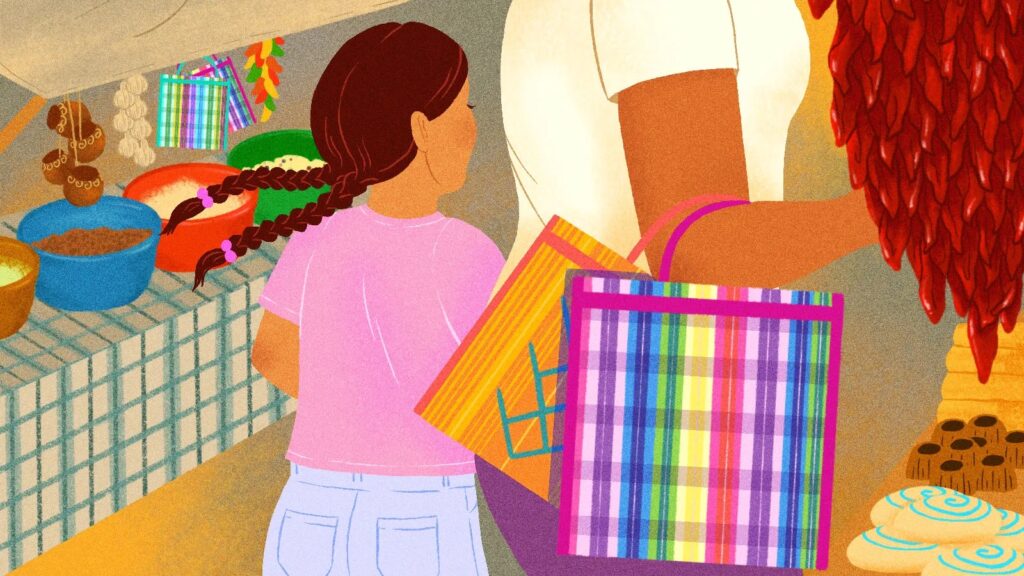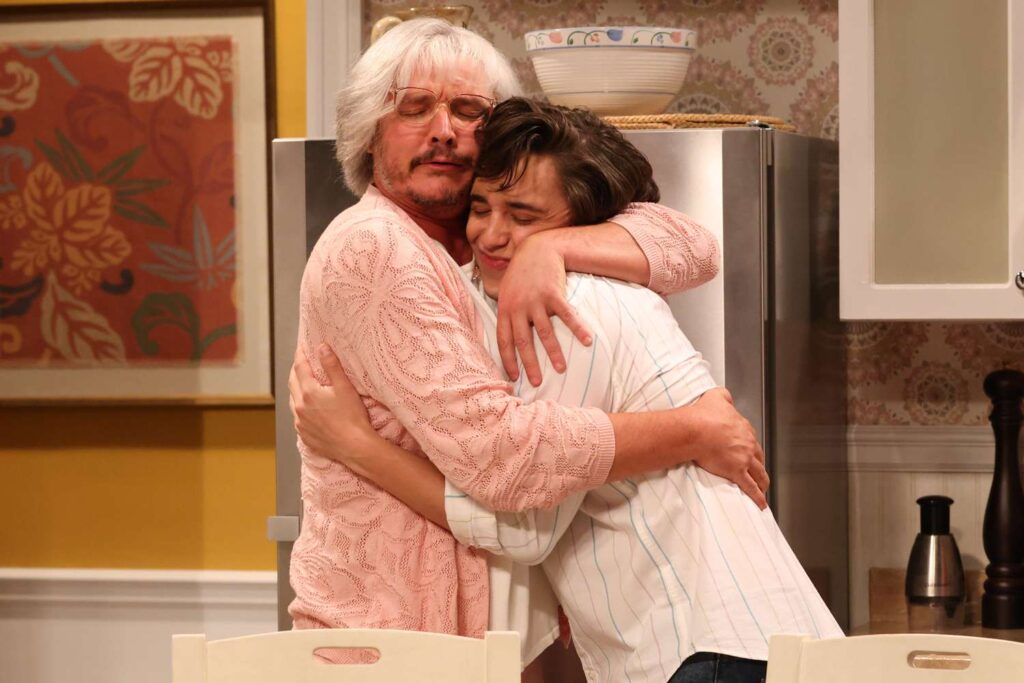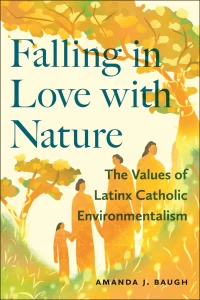Abuelita Ecologies
A review of “Falling in Love with Nature: The Values of Latinx Catholicism”

(Image source: Amelia Bates/Grites)
In 2023, Saturday Night Live aired two skits titled “Protective Mom.” Written by and starring cast member Marcello Hernandez, the sketches tell the story of a young Latinx man named Luis who brings his white girlfriend home to meet his family. In the first sketch, Hernandez explains to his date that his mother—played by Chilean-American actor Pedro Pascal—can be slightly overprotective (which turns out to be an understatement). In the follow up, “Protective Mom 2,” Luis takes a different girlfriend home to meet his aunt—played by Puerto Rican rapper Bad Bunny—but discovers to his dismay that his mother is waiting for them at his aunt’s house. In both sketches, Hernandez and his maternal figures argue vociferously in Spanish (left untranslated for the viewer) about his inadequate number of phone calls to them, his mental health, his body weight, and his choice of companion. In neither sketch is a translation necessary, as it is plainly obvious to the viewer that Mamá does not approve of “mi hijo lindo’s” novia.
The two skits were wildly popular where I live in Miami, in part because Hernandez is a Cuban- and Dominican-American from this city. But an element of the sketches endlessly rehashed locally were Mamá’s actions, which nearly every resident of this majority-Latinx community recognized from their own family: carefully folding and then saving the brown paper bag that had contained the vegan sliders Luis’s first date brings (after Mamá deposits the sliders in the trash), re-filling the emptied cookie tin Luis’s second date offers with her own sewing supplies, complaining to tia that this wealthy novia probably buys all her groceries at Trader Joe’s, and then finally being won over by Luis’s first date offering to say grace before the meal (“Luis,” Mamá exclaims, “why didn’t you tell me she was a woman of God?!”) and by his second date asking if they can start dinner so all the food doesn’t go to waste (to which Mamá and tia both enthusiastically reply that Luis should marry her as soon as possible).

(Pedro Pascal and Marcello Hernandez in SNL’s “Protective Mom.” Source: Will Heath/NBC via Getty)
Aside from the petty disposal of the vegan sliders, Mamá’s actions were recognizable to my local community in part because they represented an underappreciated ethic of environmental sustainability that author Amanda J. Baugh explores in depth in her book, Falling in Love with Nature: The Values of Latinx Catholic Environmentalism (NYU Press, 2024). The book itself is born out of Baugh’s personal experience of teaching courses on religion and environmentalism at California State University, Northridge for over a decade. It was through discussions with her students at this Hispanic-serving institution that Baugh came to realize that, as she puts it, “many of the ‘non-environmentalists’ sitting in my classroom embraced numerous measures often associated with ecologically sustainable living.”
Despite being a committed environmentalist, Baugh realized that “my carbon footprint far outweighed that of my students, who did not take conscious measures to protect the earth but whose lifestyles had far less impact.” This moment of radical honesty opens Baugh to the understanding that “who can count as an environmentalist and what can count as environmentalism” is broader than either she or her students thought.
 From this perspective, Baugh begins the project that will become this book, in which she explores the concept of la tierra environmentalism—a form of environmental stewardship and care she defines as “an embodied ethic of living lightly on the earth that is rooted in a sense of love and respect for God, fellow humans, and the rest of God’s creation.” While on its face this type of ethic has historically been represented as a function of economic necessity, rather than spiritually-based environmental stewardship, Baugh’s argument is that la tierra environmentalism is actually an overlooked environmental practice that is invaluable to all of us. Through her ethnographic research of Catholic communities in and around Los Angeles, Baugh builds a persuasive argument that Latinx Catholics express a powerful ecological consciousness that is both inherently sustainable and spiritually grounded in ways often invisible to mainstream environmental movements.
From this perspective, Baugh begins the project that will become this book, in which she explores the concept of la tierra environmentalism—a form of environmental stewardship and care she defines as “an embodied ethic of living lightly on the earth that is rooted in a sense of love and respect for God, fellow humans, and the rest of God’s creation.” While on its face this type of ethic has historically been represented as a function of economic necessity, rather than spiritually-based environmental stewardship, Baugh’s argument is that la tierra environmentalism is actually an overlooked environmental practice that is invaluable to all of us. Through her ethnographic research of Catholic communities in and around Los Angeles, Baugh builds a persuasive argument that Latinx Catholics express a powerful ecological consciousness that is both inherently sustainable and spiritually grounded in ways often invisible to mainstream environmental movements.
In the first chapter, “Loving Nature is Fundamental: La Tierra Environmentalism and Latinx Catholic Imaginations,” Baugh explores the connections her interlocutors build between their own feelings about the natural world, their sense of obligation to care for God’s creation, and how their practical actions—such as growing food, conserving water, or reducing waste—are rooted in their or their family’s experiences of connectedness to the land. She realizes in her first interviews at a Catholic church in a working-class suburb that she was “setting up religious and environmental values as two separate things…[but the church members] helped me understand that they did not think of their understandings of nature as environmental; they thought of them as religious.” Their love for nature is integrated into their religious identity and their everyday lives. The following chapter, “’I’m Supposed to Be a Practicing Christian!’: Environmental Values and Catholic Identity,” elaborates on the sacred obligation to care for nature by delving into how environmental values are tied to Catholic identity; Latinx Catholics, in particular, understand “environmental stewardship” not as a function of science or politics, but a divine responsibility. Several of her interviewees “suggested that taking measures to protect the environment”—not throwing clothes away, taking care of trees, not using Styrofoam, not wasting food—were “an important way to practice their faith.”
This alignment of ecological responsibility with Christian beliefs is, Baugh finds, an intergenerational value that arises through both family and culture in what she calls “abuelita theology.” In chapter three, “Abuelita Theology and Inherited Environmentalism,” Baugh writes that in contrast to dominant narratives that “trace environmentalism to European intellectuals and the conversationist efforts of wealthy white men,” her interlocutors identified the Latin American women who raised them as “the original environmentalists” —especially their “abuelitas” (a diminutive of the Spanish word for grandmother and a term of endearment). While many of Baugh’s interviewees are second-generation and middle class, they still engage in the practical, cultural, and (as it happens) environmentally-sustainable practices of “reduce, reuse, recycle” taught to them not by the environmental movement, but by their abuelas. And in fact, it is this way of thinking that culminates in the anecdote that gives the chapter its subtitle, “Of Course it’s Not Butter, It’s Salsa!”: playing on the famous marketing campaign “I can’t believe it’s not butter!,” a woman jokes that you always need to check the contents of the condiment containers and food packages at her grandmother’s house because what you thought was a tub of margarine in abuela’s refrigerator might actually be homemade salsa. (Similar observations are made about Royal Dansk butter cookies tins, which is why my Latinx Miamian friends howled with laughter when Mamá meticulously fills one with her sewing supplies in the SNL skit.)
It is in the fourth chapter, “Catholic Environmentalism in a White Racial Frame: Creation Sustainability in Los Angeles,” that Baugh explores the tension between la tierra environmentalism and the dominant “white racial frame” in environmentalism. She argues that the former tends to be excluded and unrecognized in dominant environmental discourses, which generally favors the latter. With an orientation toward science and based on a long history of ecological systems management, the “white racial frame” that shapes U.S. environmentalism is invaluable; but, Baugh argues, that environmentalism is often privileged at the expense of the kind of “creation sustainability” practiced in Latinx communities. Baugh explores how in Los Angeles, in particular, Latinx Catholics ground their environmentalism in community, social justice, and a spiritual connection to the land, in contrast to a more general American environmentalism that prioritizes scientific and individualistic frameworks for taking action.
In her final two chapters, Baugh dives deeper into the intersections of Catholic teachings, individual practices, and the perspective of the Church as a whole on the topic of environmentalism. In “Fe y Ecología: Praising Jesus and Fighting for the Earth,” Baugh explores how faith (“fe”) and ecology are fused in many Latinx Catholic communities; prayer, communal worship, and youth outreach are merged with activism in an example of the kind of creation sustainability she highlighted in the previous chapter. The final chapter—“God’s Plan for Creation and the ‘Little Way of Love’: How the U.S. Church Has Responded to Laudato Si”—raises these actions to the macro scale. Baugh analyzes the U.S. Church’s reaction to Pope Francis’s 2015 encyclical, Laudato Si—which argued for care for God’s creation, justice for the poor, and urgent environmental action—compared to the local responses of her interlocutors in Los Angeles. Ultimately, Baugh finds the response predictably mixed, with the local Latinx community expressing their agreement and enthusiasm for the encyclical’s message while the larger institution continues to focus its attention elsewhere.
I read Baugh’s book when Pope Francis was convalescing but did not yet appear to be fatally ill; I am finishing this review just weeks after his passing at the age of 88. But as I think about Baugh’s book and her splendid observations about a community too often ignored by mainstream environmentalists, I am reminded that the moment she captures and the people she interviews are an indelible part of the late Pope’s legacy: a community of individuals who are certain it is their duty to protect the vulnerable—everyone from the poor to the planet itself—through their actions and the love in their hearts for what the Pope’s namesake, Saint Francis, called “the democracy of all of God’s creatures.”
And with those insights, at the book’s end Baugh concludes with a personal reflection on how ecological wisdom can be found in unexpected places—church basements, college classes, backyard gardens—where love for God and the Earth are inseparable. Likewise, I am now thinking about how Baugh’s powerful reimagining of environmentalism brings me squarely back to my own family’s story where I grew up in California. Because the portion of the book dearest to my heart was Baugh’s exploration of “abuelita theology,” which reminded me of my Latina grandmother, Carmela. The daughter of a Cuban mother and a Mexican father, my “abuelita” would have objected to the name, not the least because she was born at a time when her parents felt it necessary to conceal their immigrant roots, speaking Spanish only at home to one another and insisting that their children speak English. But like many people who grew up during the Depression, my grandmother was both thrifty and practical. Food was never wasted. Family and neighbors (which in Carmela’s case were the same thing) were collectively cared for and herded to St. Angela’s Catholic Church every Sunday morning. Younger children wore the hand-me-down clothes of their older siblings or cousins. Everyone worked from a young age to help support the family, but also to share with the less fortunate. And even on the foggy and cold California coast, she was determined to grow her own food (it didn’t go well).
But the ethic of la tierra environmentalism that fascinates Baugh is perhaps most embodied by my Latina grandmother’s white husband, John. My grandfather was born to poor Missouri farmers, and he never forgot the hard lessons of his youth in care and conservation. Like SNL’s Mamá, and to the exasperation of his family, he had drawers full of paper grocery bags that he saved for everything from storage to gardening and dozens of reused coffee tins in the garage filled with nails, bolts, and screws. And like Baugh’s subjects, he was an adept conserver of resources: saving bread bags and empty margarine containers for food storage (who needs Tupperware because “of course it’s not butter!”?), refusing to replace clothes or furniture until they were well and truly used, i.e., worn threadbare, and capturing California’s sparse rainwater in barrels and buckets. He was both notorious and a hero in his neighborhood for the lengths he would go to conserve water; years before water-strapped Californians were placed on rations, my grandfather was carrying the Rubbermaid container he used for washing dishes outside after dinner to water his wife’s peach trees. He, like Baugh’s subjects, was an environmentalist before it was cool or prescribed by Pope Francis in Laudato Si.
And therein lies my favorite insight of Baugh’s book: the ecological wisdom contained in the daily lifestyles of the poor or those who grew up familiar with generational poverty, as well as folks who live closest to the land. Baugh’s description of an interviewee’s backyard garden reminded me of an acquaintance from rural Georgia laughingly asking me to excuse her “hillbilly ways” as she showed me her container garden—made up of old car tires and paint buckets filled with soil—where she was growing tomatoes and onions on her back porch. Another of Baugh’s interlocutors—who asserted that she would take the paper coffee cup she was using during their interview home to reuse until it broke down—recalled a teacher of mine who grew up in a poor Jewish family and saved his coffee cart cups in his desk drawer to use for refills until the paper became porous. Like my own friends and family, none of Baugh’s interlocutors and students have forgotten the lessons of connecting to the divine in nature through stewardship. Baugh champions the genius of this conservation born from necessity, because it is exactly the ethic—take enough, not too much—that the world needs most right now. Whether it is a catholic understanding of living lightly on the Earth or a Catholic belief in the holiness of Creation, we can all benefit from the wisdom of la tierra environmentalism in our “care for our common home.”
Catherine Newell is a professor of religion and science at the University of Miami. She is the author of the books Destined for the Stars: Faith, the Future, and America’s Final Frontier and Food Faiths: Diet, Religion, and the Science of Spiritual Eating.